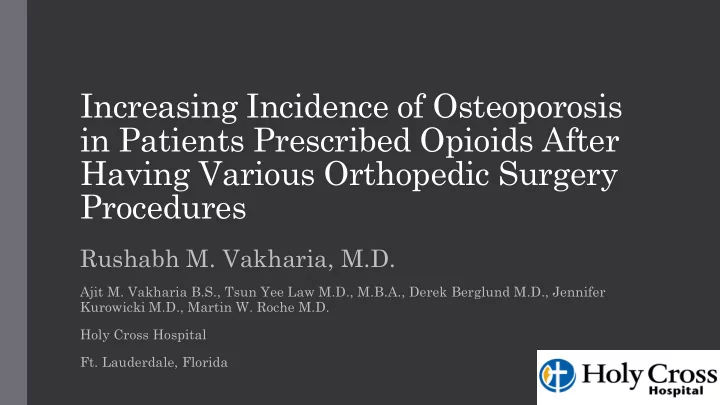

Increasing Incidence of Osteoporosis in Patients Prescribed Opioids After Having Various Orthopedic Surgery Procedures Rushabh M. Vakharia, M.D. Ajit M. Vakharia B.S., Tsun Yee Law M.D., M.B.A., Derek Berglund M.D., Jennifer Kurowicki M.D., Martin W. Roche M.D. Holy Cross Hospital Ft. Lauderdale, Florida
NO DISCLOSURES
BACKGROUND • Orthopedic Surgeons are the third leading prescribers of opioids to patients. • Approximately 21% - 29% percent of patients prescribed opioids for chronic pain misuse them. • 8% - 12% develop an opioid use disorder. • 4% - 6% who misuse prescription opioids transition to heroin. Image Courtesy of: www.aarp.com • ~80% of patients who use heroin first misused prescription opioids.
PURPOSE The primary aim of this study was to ascertain the incidence of patients who develop osteoporosis after being on opioids for 5 years; after having had certain Orthopedic Surgery procedures. Opioids HPA OBC Decrease T and E synthesis Decrease synthesis Osteoporosis
METHODS • A retrospective review of the Pearl Diver database from 2008 – 2016 was done, by searching through various International Classification of Disease, ninth edition codes (ICD-9) and generic drug codes were used. • Patients with no prior history of osteoporosis, osteopenia, opioid abuse or disorder were queried. Patients with a body mass index <30, smokers, chronic liver disease, chronic kidney disease, and use of certain medications were also excluded from the study. Out of this population, the number of patients who developed osteoporosis after being on opioids for 5 years were collected. • Incidence of osteoporosis after various Orthopedic procedures were compared. Procedures which were looked at included TKA, THA, SF, and RSA.
RESULTS • 219,885 patients (males: 122,880, females: 97,005) without a history of osteoporosis or osteopenia were found. • 12,312 patients (males: 2,468, females: 9,844) developed new onset osteoporosis within 5 years of being on opioid use following various Orthopedic Surgery procedures. • Average number of days until development of Osteoporosis after being placed on opioids following Orthopedic procedures was 409.12 + 503.91; whereas those patients who were diagnosed with “Opioid Dependence” the average number of days was 124.27 + 134.64 days.
RESULTS Years New-Onset Osteoporosis 2008 2,426 2009 2,913 2010 3,613 2011 4,381 2012 2,283 2013 1,931 2014 1,501 2015 1,002 2016 204 Table 1. New-Onset Osteoporosis from 2008 – 2016 After Various Orthopedic Surgery Procedures
ODO Matched Control Total Number 158 226 Demographics Female 123 182 Male 55 44 Age 45 to 49 13 21 50 to 54 19 31 55 to 59 25 30 60 to 64 33 33 65 to 69 26 34 70 to 74 16 33 75 to 79 -1 19 80 to 84 -1 11 Table 2. Opioid Dependence Osteoporosis (ODO) vs Matched Control Cohort Population
LIMITATIONS • The research design is dependent on ICD-9, ICD-10, and/or CPT codes to isolate diagnoses, procedures, and complications.
CONCLUSIONS • Long term use of opioids does lead to development of Osteoporosis in patients. • Utilization of DEXA scan on patients after being on opioids for more than 1 year may help reduce the incidence of osteoporosis in this population. • We recommend supplementation of Calcium and Vitamin D to potentially antagonize the effects of opioids on bone mineralization.
REFERENCES • Deborah Dowell, Elizabeth Arias, Kenneth Kochanek, Robert Anderson, Gery P. Guy, Jan L. Losby, Grant Baldwin. Contribution of Opioid-Involved Poisoning to the Change in Life Expectancy in the United States, 2000- 2015. JAMA. 2017;318(11):1065–1067. doi:10.1001/jama.2017.9308 • Ringwalt C, Gugelmann H, Garrettson M, et al. Differential prescribing of opioid analgesics according to physician specialty for Medicaid patients with chronic noncancer pain diagnoses. Pain Research & Management : The Journal of the Canadian Pain Society . 2014;19(4):179-185.
Thank You!
Recommend
More recommend